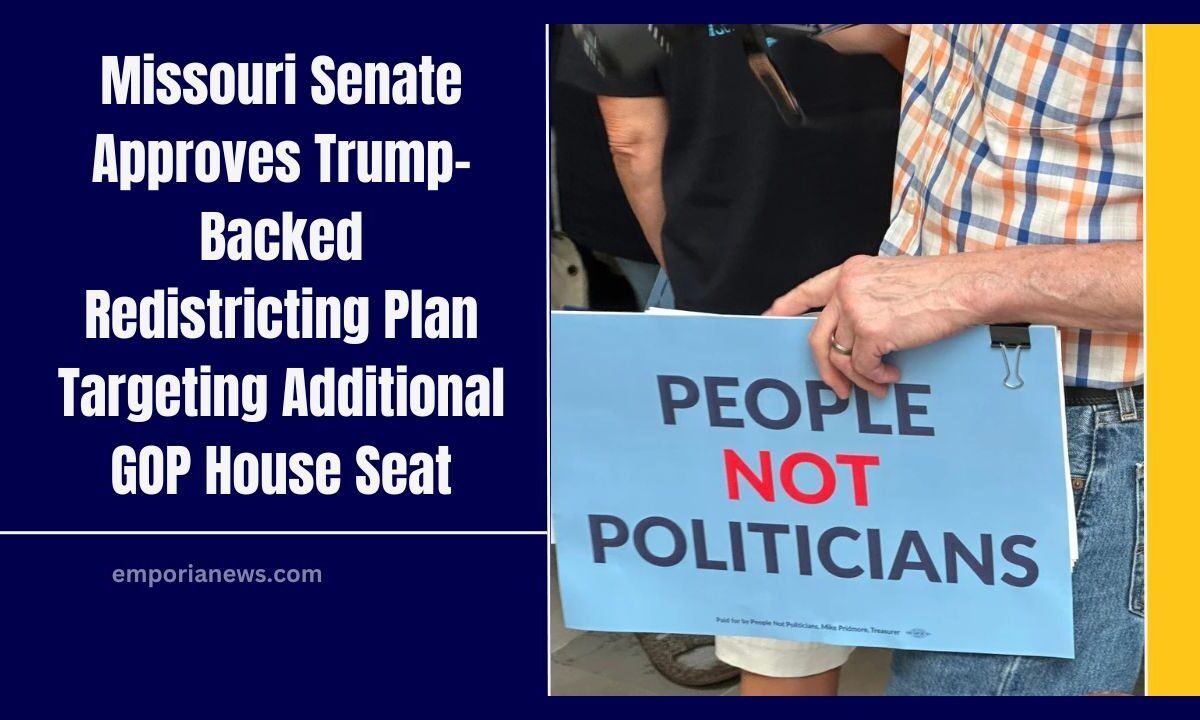The Missouri Senate has passed a controversial redistricting plan backed by former President Donald Trump, aiming to help Republicans capture an additional U.S. House seat ahead of the 2026 midterm elections. The plan now heads to Republican Governor Mike Kehoe, who has vowed to sign it into law.
If enacted, the new map would redraw Missouri’s eight congressional districts to strengthen the GOP’s already dominant hold and weaken Democratic Rep. Emanuel Cleaver’s Kansas City-based district, sparking intense legal and political battles.
Key Details of the Plan
The redistricting proposal, approved during a special legislative session, is designed to shift Cleaver’s district into more Republican-leaning rural areas, significantly reducing its Black and minority population.
| Key Element | Details |
|---|---|
| Sponsor | Rep. Dirk Deaton (R) |
| Governor | Mike Kehoe (R), supports the plan |
| Targeted Seat | Rep. Emanuel Cleaver (D–Kansas City) |
| Current Party Split | 6 GOP, 2 Democrats |
| Projected Impact | Could shift 1 Democratic seat to GOP |
| Legal Actions | 3 lawsuits + referendum petition planned |
Missouri joins Texas and California in pursuing mid-decade redistricting, breaking from the tradition of only redrawing maps after the decennial census. Trump praised the map on social media as “much fairer” and said it would send “an additional MAGA Republican to Congress.”
Political and Legal Fallout
Missouri Democrats and civil rights groups have decried the plan as an unconstitutional racial gerrymander that splits Kansas City’s historically Black neighborhoods.
- Three lawsuits have been filed, including one from the NAACP
- People Not Politicians launched a referendum petition drive, needing over 100,000 signatures in 90 days to force a statewide vote
- Senate Minority Leader Doug Beck (D) pledged to personally help gather signatures
Elsa Rainey, spokesperson for the petition group, declared, “This fight is not over. Missouri voters—not politicians—will have the final say.”
A hearing is scheduled Monday in one of the ongoing court challenges.
Impact on Emanuel Cleaver’s District
Rep. Emanuel Cleaver, Kansas City’s first Black mayor and a 20-year congressional veteran, has vowed to challenge the map in court and run for reelection regardless of how his district is redrawn.
The revised district would extend about 180 miles southeast from Kansas City to rural Vienna, slicing through neighborhoods with stark racial contrasts:
| Location | % Black Residents | Notes |
|---|---|---|
| St. James UMC area (Kansas City) | ~60% | Cleaver’s longtime church, predominantly Black community |
| Vienna area (rural Missouri) | <1% (11 Black residents of 2,500) | Largely white, conservative |
Sen. Barbara Washington (D–Kansas City) called the map an attempt to “erase the voice of my community,” while local resident Roger C. Williams Jr., 79, said it echoes the racial discrimination he saw in his youth.
Republican Response and Strategy
Republicans defended the map, claiming it splits fewer counties and municipalities than the current one and better aligns with Missouri’s conservative values.
Senate President Pro Tem Cindy O’Laughlin (R) said it “strengthens Missouri’s conservative voice and ensures every Missourian is fairly represented in Washington.”
The plan passed only after Republicans changed Senate rules to cut off Democratic debate, highlighting the high-stakes partisan nature of this redistricting fight.
The Trump-backed Missouri redistricting plan could reshape the state’s political landscape, potentially flipping one of its two Democratic-held House seats to Republican control. But with multiple lawsuits and a referendum drive underway, its fate remains uncertain.
As Missouri becomes a focal point in a national redistricting battle, the outcome could prove pivotal in determining which party controls the U.S. House in 2026.




